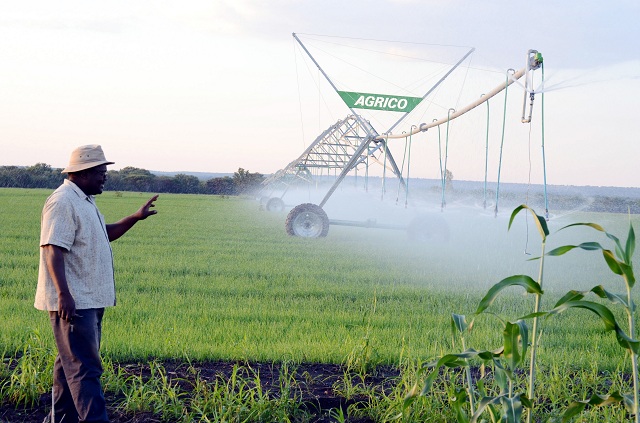
The Sunday News

 Ndodana Sibanda demonstrates how the centre pivot works to water the wheat at Arda Jotsholo recently. (Picture by Nkosizile Ndlovu)
Ndodana Sibanda demonstrates how the centre pivot works to water the wheat at Arda Jotsholo recently. (Picture by Nkosizile Ndlovu)Dumisani Nsingo, Senior Farming Reporter
AT least 150 hectares of winter wheat crop have been planted at the Agricultural and Rural Development Authority (Arda)’s Jotsholo Estate in Lupane heralding the commencement of production after a partnership with Trek Petroleum signed late last year.
Arda Jotsholo manager Mr Ndodana Ncube said the wheat was cropped during the first week of last month to the third week of the same month and its germination percentage was above 85 percent.
At its peak the agricultural project used to produce five to six tonnes of maize per hectare and four tonnes of wheat per hectare but the tonnage realised from the production of both cereals started deteriorating from 2012 to about two tonnes per hectare.
Arda also used to crop, process and package rice at its state-of-the-art plant at the estate from the 1990s until 2006.
Arda severed ties with its Chinese partner, Sinotex Zimbabwe last year after the two parties failed to agree on certain terms pertaining to the agreement.
Sinotex Zimbabwe had cropped 103 hectares of cotton and managed to harvest 58 tonnes. However, the institute was to partner new investor, Trek Petroleum trading as Jopa Investments in a Public-Private Partnership (PPP) agreement.
“We planted 75 hectares in the first week of April and the rest was planted in the last week of the same month to make it 150 hectares. Our target is to produce 20 tonnes per hectare and we are looking forward to harvesting between August and September,” Mr Ncube said.
He said the remaining 50 hectares, which makes up for the total 200 hectares of one of the estate’s two farming areas could not be utilised due to non-functioning electrical cables that cut across a section of the field.
“We, however, could not utilise the remaining two centre pivots as Zesa is still to remove a malfunctioning line, which cuts across the area where the two centre pivots should operate. It wanted $17 000 to remove the line and we have since paid it and their service is long overdue,” Mr Ncube said.
He said 20 hectares of the remaining 50 hectares would be put under horticultural production with the crops being irrigated using water drawn from a borehole within the confines of the field.
“Immediately after harvesting the wheat we will install the two centre pivots to ensure that we utilised the entire 200 hectares. We will put summer maize while we will be developing the other section which is 300 hectares through enacting both the fence and centre pivots.
“We intend to put centre pivots that cover 50 hectares each as we are now confident that this equipment can operate in clay soils unlike what has been previously perceived. The 300-hectare section will be irrigated by water obtained from an infield earth dam,” Mr Ncube said.
He said the central pivot irrigation was more efficient and water conservative than the flooding irrigation system that was previously used at the estate.
“Our old system, the flood system demanded more usage of water while centre pivots conserve water and are more efficient,” Mr Ncube said.
Arda board chairman, Mr Basil Nyabadza praised the PPP arrangement for its role in facilitating modern farming technologies that are aimed at improving productivity at the institution’s estate.
“We are very happy about the investment that we have managed under the PPP arrangement. Through it we have managed to revamp our piping system at the dam and managed to install a modern reservoir on field as well as well as having centre pivots.
“These are new technologies, possibly the first in the country. The centre pivots are sensitive to the cost and utilisation of water. We are also happy that we now have a cereal crop there which is very important in ensuring food security in the country,” Mr Nyabadza said.
Centre pivot irrigation typically uses less water compared to many surface irrigation and furrow irrigation techniques, which reduce the expenditure of and conserves water.
It also helps to reduce labour costs compared to some ground irrigation techniques, which are often more labour-intensive.
Some ground irrigation techniques involve the digging of channels on the land for the water to flow, whereas the use of centre-pivot irrigation can reduce the amount of soil tillage that occurs and helps to reduce water run-off and soil erosion that can occur with ground irrigation.
Less tillage encourages more organic materials and crop residue to decompose back into the soil, and reduces soil compaction.



